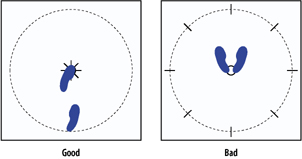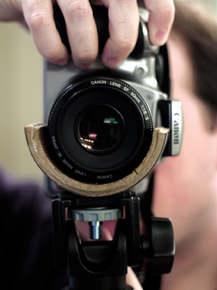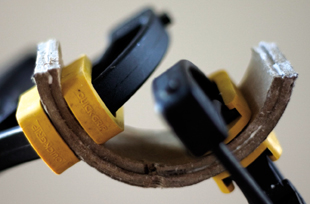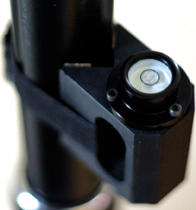Hack 95 Advanced Panorama Technique
| < Day Day Up > |
| Once you've played a bit with panoramas, you might want to raise the bar and produce professional-quality images. Here are some secrets the pros use . [Hack #19] discussed the basics of capturing photos to be stitched into panoramic images, including putting the camera on manual exposure, using a fixed white-balance setting, and maybe even using manual focus. One trick you might not be using to broaden your shots is turning the camera vertically. Though you'll have to take more shots to span the same 180 scene, you'll capture more height in your composition. When positioning the camera, it's import to keep it level. If your horizon is flat, you can use it as a guide. Better yet, you can use a hot-shoe level [Hack #9] where your flash would normally go. Once the camera has been leveled, don't continue to fiddle with its alignment; you'll have a harder time stitching the images together on the computer. 8.11.1 Avoiding ParallaxOne of the most important terms related to panoramic photography is parallax . Parallax is the very thing that gives humans depth perception, but it is the enemy of panoramic photography. Here is a demonstration of parallax. Hold your finger out at arm's length; first close one eye, then the other. You finger moves relative to objects in the background. This is how we perceive depth. Now, while your hand is still out, close one eye again and this time rotate your head. You notice that your finger still moves relative to the background. This is because you rotate your head around your neck rather than your eye. If you were able to rotate around your eye, your finger would not move relative to the background. When taking panoramic photographs, your goal is the lack of a parallax when you rotate the camera. It's not really an issue if you are shooting a distant landscape without any foreground objects, but as objects get closer, minimizing the amount of parallax (known as the parallax error ) becomes more important. So how do you avoid parallax? Well, every camera has an axis point beneath the lens (commonly referred to as the nodal point ) around which you can rotate the camera to avoid any parallax error. This point is typically inside the lens. Once you have a method for holding the camera, you can use a little trial and error to hone in on just the right spot. I'll describe a technique for this later. Don't worry about perfection on this; for most shots, you don't have to be perfect, just in the ballpark. However, if you are shooting in a small, confined space, such as a car or small room, you want to put some time into finding the nodal point. One option for successful camera rotation is to use a high-end, professional panoramic head. These are stable and easy to work with, but they're also expensive and heavy. Many of the companies that offer high-end panoramic heads also build entry-level models that are more in line with a typical consumer's budget. These panoramic heads mount the camera vertically and then offset it back and to the side so that the nodal point is over the center of the tripod. They also click in at set increments as you rotate, making it easy to get shots at equal spacing. For example, every 45 degrees might result in eight shots for a full 360-degree circle. So, you're not ready to buy one of these? No problem; you can still capture excellent panoramas without one. Even the pros who use the high-end panoramic heads still find themselves in situations where they want to shoot a panoramic photo but can't drag all the equipment along. 8.11.2 Expert Hand-held Panorama TechniqueWhen shooting panoramas, the natural tendency is to rotate around your heels with the camera out in front of you; however, you should not do this. As shown in the right half of Figure 8-25, when you rotate around your heels, the camera lens circumscribes a large circle. Figure 8-25. Proper handheld panorama technique This is bad because the nodal point in the lens, represented in Figure 8-25 as short black lines, is nowhere near your center of rotation. Because of this, you have introduced a parallax error, just as you did when you turned your head with your finger out. Instead, you should keep the lens position stationary, as shown in the left half of Figure 8-25. Stand with your left foot forward and right foot back. Place the ball of your left foot directly under the camera lens. Play around with your stance and the spread of your feet until it feels comfortable. Then, rotate around the ball of your left foot . The camera lens should stay at the same spot, while your right heel makes a circle. 8.11.3 The Cardboard-Tube CradleI have come up with a solution that is somewhere between hand-holding and using a full panoramic tripod head. This technique is ideal to use with a monopod and is best described as a lens cradle . I don't want to use the word mount , because the camera is not really mounted to the cradle; it just rests there, as shown in Figure 8-26. When using the cradle, I recommend you keep a hand on the camera and keep the neck strap around your neck. Figure 8-26. Cardboard-tube cradle The only raw material you need to build this cradle is a tube. I used a heavy-duty cardboard tube, but I don't see any reason why you couldn't use PVC or some other material. The tube should have a diameter of roughly three inches. For tools, you'll need a knife or saw to cut the tube, and a drill with a 3/16" bit. Here are step-by-step instructions for how to assemble the lens cradle:
Figure 8-27. Gluing together layers of your cradle Once you screw the tube onto the monopod, you're ready to go. Turn the camera sideways , rest the lens in the cradle, and shoot. You should focus ahead of time because the cradle might interfere with focusing, and you should also take care to keep the monopod level. Mounting a level on the monopod, as shown in Figure 8-28, can make this easier. Also make sure that the camera is level in the cradle, not tilted up or down. Figure 8-28. Bubble level attached to a monopod So, now that you know how to rotate around the nodal point, how do you fine-tune the location of the nodal point for your lens? Basically, it's done by trial and error. Set up for a panoramic photo in a location where you have one vertical element close to the camera and another vertical element off in the distance. Place the camera with just a sliver of space between the two vertical elements. Rotate the camera to the left and then to the right. If that gap does not disappear or grow, you are right where you need to be. If the gap does change, try sliding the camera forward or backward in the cradle. If it gets worse , you went the wrong way or just went too far. Just keep adjusting with small moves until you are happy with the results; then make a mark on the cradle for future reference. Keep in mind that the nodal point of a lens will change as you zoom your lens, but most of the time, you will be shooting panoramic photos at the full, wide setting of the lens. Perfecting your panoramic photography skills takes a while, but putting in the time up-front to learn how to get the best photos will save you time at the computer and give you a better photo in the end. David Goldwasser |
| < Day Day Up > |
EAN: 2147483647
Pages: 161